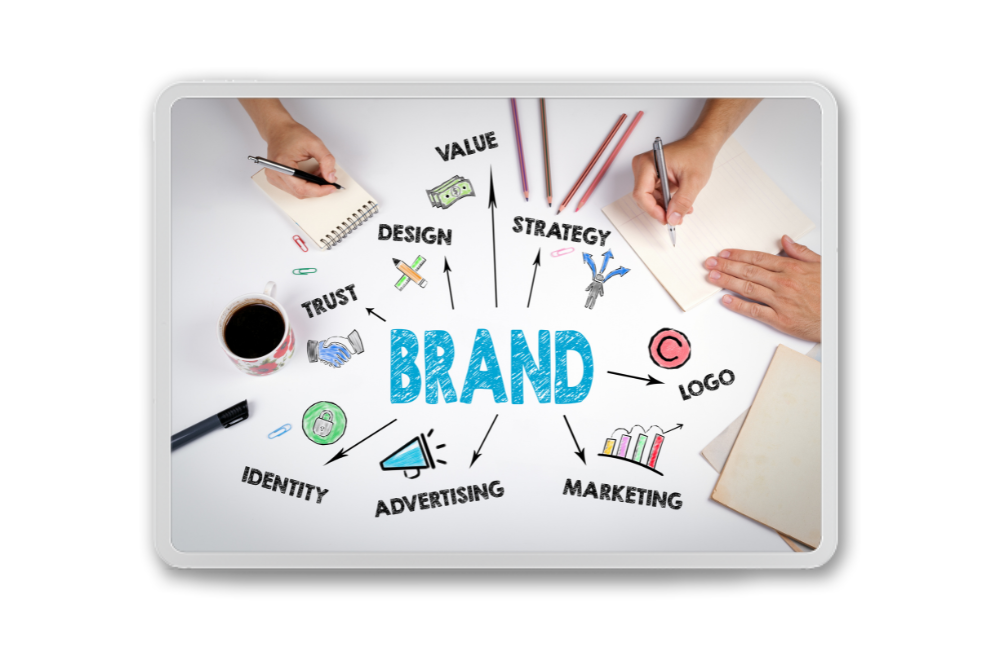Before setting up a business, you will need to come up with branding guidelines. What are branding guidelines? They are rules that dictate how your company will present itself to the world. The guidelines include everything from the fonts you will use in your marketing materials to the colours you choose for your website. In this blog, we will discuss what branding guidelines are and why they are important. We will also give you a few tips on how to create effective branding guidelines for your business.
Importance of Branding Guidelines
Creating branding guidelines is important because it helps to ensure that your company presents a consistent message to the world. In addition, a set of guidelines makes it easier for your team members to know what they can and can’t do when creating marketing materials or working on other projects. It also helps to keep your brand identity strong, which can attract new customers and help you retain the ones you already have.
Define your Brand Identity
Before you can create branding guidelines, you need to have a clear understanding of your brand identity. For example, what are your company’s values? What message do you want to communicate to your target audience? Once you have answers to these questions, you can start working on creating guidelines that reflect your brand identity.
Brand Purpose
Every business has a different purpose for existing. What’s yours? This is the first question you need to answer before building your guidelines. Once you know your brand’s purpose, creating messaging and visuals that align with it will be much easier.
Mission Statement
After you have defined your brand’s purpose, you should create a mission statement. This will be a short sentence or paragraph that sums up what your company is all about. It can be helpful to refer back to your mission statement when creating branding guidelines, as it will keep you focused on what’s most important.
Visual Identity
Your visual identity is how your brand looks and feels. It encompasses the tiniest details, from your logo to the colours you use on your website. When creating branding guidelines, you will need to include information on how to use your logo and what colours and fonts should be used in marketing materials.
Choose your Colours
Your brand’s colours are one of the most important aspects of its identity. Therefore, they should be chosen carefully to reflect the mood and message you want to communicate. When choosing colours for your branding guidelines, consider what each colour represents and how it will be used. For example, you might choose a very light blue for your website’s background colour because it represents calm and serenity. But you might choose a bright orange for your call-to-action buttons because it represents excitement and energy.
Select your Fonts:
The fonts you use in your branding will also play a role in conveying your message. For example, if you want to communicate that your brand is modern and cutting-edge, you might choose a sans-serif font like Arial or Helvetica. On the contrary, if you aspire to convey a more traditional message, you might choose a serif font like Times New Roman.
Decide on your Logo:
Your logo is one of the most critical elements of your brand. It should be simple, memorable, and recognisable. When designing a logo, keep your branding guidelines in mind. For example, ensure the colours and fonts you use are consistent with the rest of your materials.
Define your Target Audience:
Before you can create practical branding guidelines, you need to have a clear understanding of your target audience. Whom are you trying to reach with your marketing efforts? What are their needs and wants? Once you have established whom you are targeting, you can start creating guidelines that appeal to them.
Creating personas is one of the best ways to get to know your target audience. Once you have a few personas created, you can start thinking about what messages and visuals will appeal to them. Then, you can begin creating branding guidelines tailored to your target audience.
Keep It Simple:
When creating branding guidelines, it is important to keep them simple. No one wants to read a long, drawn-out document full of technical jargon. So instead, focus on creating guidelines that are easy to understand and follow. Include clear instructions and examples whenever possible.
Guidelines are important in conveying your message and maintaining a consistent look and feel for your brand. But, before creating effective guidelines, you must understand what they are and why they are essential.
A branding guideline is a document that outlines how a company’s brand should be used. It can include everything from the colours and fonts that should be used in marketing materials to the tone that should be used in communications. Branding guidelines are important because they help to ensure that all of a company’s marketing efforts are uniform across all mediums. This, in turn, makes it easier for customers to recognise and remember the brand.
Benefits of Brand Guidelines
There are many benefits to having brand guidelines, including the following:
Consistent message to the world:
Having a set of guidelines ensures that everyone in your company is presenting the same message to the world. This consistency makes your brand unforgettable and allows customers to remember and recognise your brand.
Keeping your brand identity strong:
If you achieve a strong brand identity, it will be easier for customers to recognise your company, even in a crowd. Branding guidelines can help you keep your brand identity strong by ensuring that all your marketing materials are consistent.
Attracting new customers:
By having branding guidelines, you can attract new customers looking for a company that communicates a reliable message.
Retaining customers:
Customers usually prefer and favour brands that they recognise and trust. Branding guidelines can help retain customers by ensuring they always know what to expect from your company.
Simplifying the design process for your team:
By having a set of guidelines, you can simplify the design process for your team. Designers will know precisely what they need to do to create materials that are in sync with your brand identity.
Helping to protect your brand identity:
Branding guidelines can help protect your brand identity by ensuring that it is not used incorrectly or unauthorisedly. With these guidelines in place, you can take action if someone tries to use your brand identity in a way that does not meet your standards.
FAQs about Branding Guidelines
Now that we have determined the value and benefits of branding guidelines let’s look at some frequently asked questions about these guidelines.
What should be included in brand guidelines?
The answer to this question will vary depending on your company and what you want to include in your guidelines. However, branding guidelines often include traditional elements: colours, fonts, and tone.
What is the difference between brand guidelines and a style guide?
A brand guideline is a document that contains the dos and don’ts of using a company’s brand, including its name, logo, colours, fonts, voice, and more. It seeks to ensure that all public-facing materials maintain a consistent look and feel that reinforces the company’s desired image. Brand guidelines may be created internally by marketing or design teams or externally by agencies hired by the company.
A style guide is similar to a brand guideline in that it establishes rules for how materials should look and be used. However, while brand guidelines focus specifically on communications related to an organisation’s image and identity, style guides can cover any topics related to an organisation’s communication.
Do I need brand guidelines?
Brand guidelines are necessary for any company that wants to create a consistent, recognisable brand image. A brand is more than just a logo or a name; it is the overall impression a company creates in the minds of its customers. Brand guidelines can help you ensure that your company’s branding is always on point, no matter who is creating or publishing marketing materials.
If you are uncertain whether you need brand guidelines, ask yourself these questions:
- Do all of my marketing materials feel like they belong to the same company?
- Do my employees know how to represent the brand correctly?
- Are my customers able to identify my company’s branding across different channels?
How often should I update my brand guidelines?
It is best to update your brand guidelines whenever there are changes to your branding – whether it is a change in logo, typeface, colour palette, or anything else.
It is also essential to update your brand guidelines when you roll out new marketing campaigns, products, or services. Keeping your brand guidelines up-to-date will ensure that your branding is cohesive and looks professional.
What are branding guidelines used for?
Branding guidelines are rules and best practices that companies use to ensure that their branding is consistent and effective. These guidelines cover everything from logo usage to the tone of voice and messaging.
Many businesses recognise the importance of having solid and consistent branding, as it can help to build customer loyalty, differentiate yourself from the competition, command higher prices and more. In addition, having clear branding guidelines in place can help to ensure that everyone involved in creating or using your brand assets is on the same page, which in turn helps to create a more cohesive and effective overall brand identity.
Conclusion:
Keeping your business above average is essential for survival in the market and the online world. So as you can see, branding guidelines are an important tool for any company that wants to create a strong and reliable brand identity. If you are unsure about your company needing branding guidelines, ask yourself the questions above. And if you do have branding guidelines in place, keep them up-to-date so that your branding always looks professional and cohesive. Read here about How can a Branding Agency Help Your Business to Grow?




